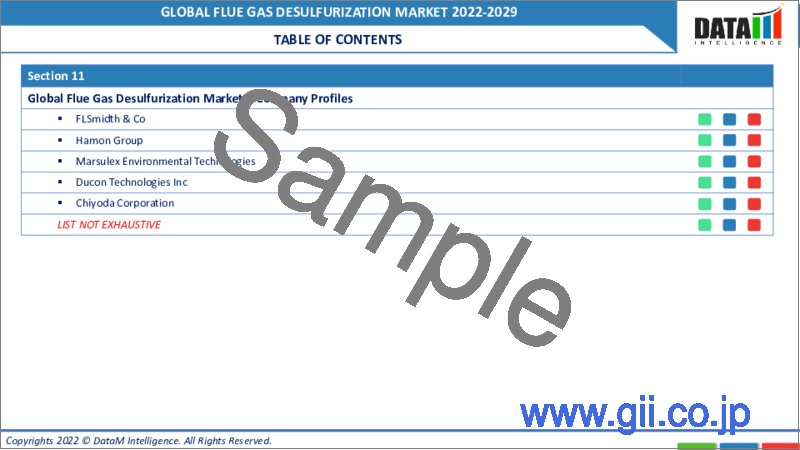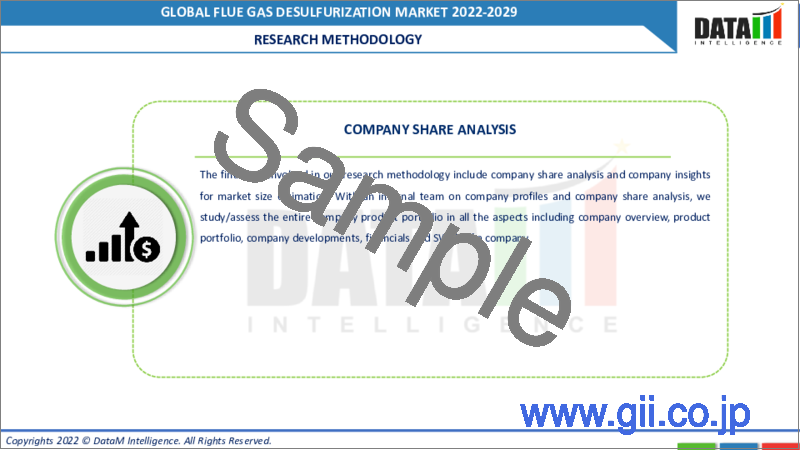|
|
市場調査レポート
商品コード
1117983
排煙脱硫装置の世界市場:2022-2029年Global Flue Gas Desulfurization Market - 2022-2029 |
||||||
|
● お客様のご希望に応じて、既存データの加工や未掲載情報(例:国別セグメント)の追加などの対応が可能です。 詳細はお問い合わせください。 |
|||||||
| 排煙脱硫装置の世界市場:2022-2029年 |
|
出版日: 2022年08月22日
発行: DataM Intelligence
ページ情報: 英文 180 Pages
納期: 約2営業日
|
- 全表示
- 概要
- 目次
世界の硫黄酸化物排出基準の厳格化により、排煙脱硫装置の市場シェアが上昇しています。アジア太平洋地域では、急速な工業化と生産活動の集中により、排ガスを削減するための脱硫装置の需要が急増しています。特に中国とインドでは、急激な電力消費と石炭火力発電の拡大が、この産業を後押しすると予測されています。
当レポートでは、世界の排煙脱硫の市場を調査し、市場の定義と概要、市場成長への各種影響因子の分析、法規制環境、市場規模の推移・予測、各種区分・主要国別の内訳、競合環境、主要企業のプロファイルなどをまとめています。
目次
第1章 世界の排煙脱硫市場:調査手法・調査範囲
第2章 世界の排煙脱硫市場:市場の定義・概要
第3章 世界の排煙脱硫市場:エグゼクティブサマリー
第4章 世界の排煙脱硫市場:市場力学
- 市場に影響を与える要因
- 促進要因
- 抑制要因
- 機会
- 影響分析
第5章 世界の排煙脱硫市場:産業分析
- ポーターのファイブフォース分析
- サプライチェーン分析
- 価格分析
- 規制分析
第6章 世界の排煙脱硫市場:COVID-19の分析
- COVID-19:市場への影響分析
- COVID-19中の価格変動
- 需給スペクトル
- パンデミック時の市場に関する政府の取り組み
- 製造業者の戦略的イニシアチブ
- 総論
第7章 世界の排煙脱硫市場:タイプ別
- 湿式FGDシステム
- 石灰岩
- 海水
- その他
- 乾式および半乾式FGDシステム
第8章 世界の排煙脱硫市場:設置区分別
- グリーンフィールド
- ブラウンフィールド
第9章 世界の排煙脱硫市場:エンドユーザー別
- 発電
- 化学
- セメント製造
- 鉄鋼
- その他
第10章 世界の排煙脱硫市場:地域別
- 北米
- 欧州
- 南米
- アジア太平洋
- 中東・アフリカ
第11章 世界の排煙脱硫市場:競合情勢
- 競合シナリオ
- 市場の位置付け/シェア分析
- M&A分析
第12章 世界の排煙脱硫市場:企業プロファイル
- Mitsubishi Heavy Industries Ltd
- General Electric Company
- Doosan Lentjes GmbH
- Babcock &Wilcox Enterprises Inc
- Rafako SA
- FLSmidth &Co
- Hamon Group
- Marsulex Environmental Technologies
- Ducon Technologies Inc
- Chiyoda Corporation
第13章 世界の排煙脱硫市場:重要考察
第14章 世界の排煙脱硫市場:DataM
Market Overview
Flue gas desulfurization market reached US$ YY million in 2021 and is estimated to record significant growth by reaching up to US$ YY million by 2029, growing at a CAGR of 5.5% during the forecast period (2022-2029).
Flue-gas desulfurization (FGD) is a compact set of technologies for removing sulfur dioxide (SO2) from fossil-fuel power plants, exhaust flue gases and other sulfur oxide-producing processes like waste incineration. Since the late 1960s, flue-gas desulfurization (FGD) systems have been utilized to reduce coal-fired power stations' sulfur dioxide (SO2) emissions. By volume, the solids produced by FGD systems are the second-largest coal combustion product (CCP) stream, behind only fly ash.
Over the projected period, rigorous air quality rules to lower SOx emission levels are expected to fuel market growth. Market growth is expected to be boosted by rising energy demand and large investments in thermal power facilities in Asian countries. Furthermore, stringent emission regulations and increased demand for FGD systems in India, Indonesia, Vietnam and South Africa are expected to boost product demand during the forecast period.
Market Dynamics
Increasing stringent standards for sulfur oxide emission across the globe is boosting the market share for flue gas desulfurizations
Increasing stringent standards for sulfur oxide emission across the globe is boosting the market share for flue gas desulfurizations
Historically, primary air pollution causes have been the power and manufacturing industries, with marine transportation joining the list in recent decades. Sulfur dioxide and different types of nitrogen oxides are released through the combustion of fossil fuels in coal-fired power plants, manufacturing facilities and marine transport, which react with air moisture and oxygen to generate sulfuric and nitric acid fumes in acid rain. The corrosive water depletes the soil's critical nutrients, preventing trees from reproducing and wreaking havoc on surrounding ecosystems.
Human health is also harmed due to direct or indirect sulfur oxide exposure, ranging from cardiovascular disease to premature mortality. As a result, removing harmful impurities such as SOx, NOx, mercury and particulate matter at the source becomes critical, creating huge opportunities for the FGD market to grow in the forecast period.
In Asia-Pacific, rapid industrialization and concentration of manufacturing activities have generated a pressing demand for FGD technology to cut emissions. Furthermore, the exponential use of electricity and the expansion of coal-fired operations, particularly in China and India, are predicted to offer this industry a boost.
Following the recent pandemic, the focus on finding solutions to climate change will bring attention to any lowering of emissions. As economies recover, governments will rush to invest in FGD technology to clean the air, reduce the risk of acid rain from nitrogen and sulfur particles and improve temperature conditions.
Increasing adoption of clean energy sources and High energy consumption of FGD system operations
The need to use renewable energy sources has been characterized by a cleaner, cooler and healthier atmosphere, resulting in less demand for carbon-based fuels. Renewable energy sources include hydropower, onshore and offshore wind; countries are pursuing solar photovoltaic energy and bioenergy. The mentioned factor is the primary impediment to the growth of coal-fired power plants, affecting the demand for FGD systems.
For instance, China's coal power capacity is fixed at 1.1 TW under the current FYP and several targets have been set to enhance the country's non-fossil energy mix share by 15%, limiting the FGD market growth. However, the Chinese government is focusing on stimulating the economy through investments. A recent move toward energy security has overshadowed worries about financial sustainability, overcapacity and the environment, increasing product demand over the forecast period.
Furthermore, An electrostatic precipitator is followed by the main desulfurization unit, a scrubber and an in-line steam reheater in a normal FGD system. The energy-intensive technology accounts for around 2.5 % to 6% of a coal-fired power plant's overall energy output capacity. As a result, operational expenses skyrocket, rendering plants with less than 500 MW capacities economically unviable.
The reheater, water, slurry pumps and tank agitation consume significant energy. Scrubber design, plant design, coal properties and regulatory limits are all elements that determine energy consumption patterns. Thus, the market for FGD systems faces a significant challenge due to these high energy requirements.
COVID-19 Impact Analysis
The pollution levels in several countries have dropped due to the COVID-19 pandemic. As per the International Energy Agency, global energy consumption is expected to fall by 5% in 2020, the largest drop in 70 years. The FGD systems industry was impacted by a disruption in the supply chain and economy, which resulted in delays, postponements and sudden cancellations of previously announced projects.
FGD systems are also widely used in the chemical and cement sectors. The COVID-19 pandemic has significantly influenced critical industries like chemical, iron, steel and cement production. Chemical demand has been severely impacted throughout end markets, causing global supply networks to be disrupted. As a result, large chemical companies' stock prices and revenue have taken considerable knocks, delaying investment in new FGD systems.
Segment Analysis
The global flue gas desulfurization market can be segmented on the type, installation, end-user and region.
Stringent removal efficiency, high emission requirements set by federal governments, growth in electricity consumption and an increase in the number of coal-fired power plants in emerging nations are all factors driving the use of wet FGD technology
The global flue gas desulfurization market is segmented based on type into wet FGD systems and dry & semi-dry FGD systems. The wet FGD system is further divided into limestone, seawater and others (ammonia and sodium). Wet FGD systems have the highest percentage of SOx removal efficiency (greater than 90%), whereas dry FGD systems have the lowest (80%). Wet systems account for more than 85 % of all FGD systems implemented globally, owing to reduced reagent and operational costs, fuel flexibility and the possibility of using by-products. Furthermore, these systems may be capable of removing oxidized mercury and have removal efficiencies of up to 99%.
Wet FGD systems often require wastewater treatment, a wet stack and chloride protective alloys or coatings, all of which add to the overall capital expenses. Dry FGD systems, on the other hand, offer cheaper initial and yearly expenses since they are simpler, waste disposal is less complicated and they consume less water.
Thus, stringent removal efficiency, high emission requirements set by federal governments, growth in electricity consumption and an increase in the number of coal-fired power plants in emerging nations are all factors driving wet FGD technology. The commercial deployment of wet FGD systems in 1970 and its high efficiency in SO2 removal contributed to the segment's rise. Furthermore, gypsum is a by-product of typical wet FGD systems that use limestone as a reagent that might be sold to cement and wallboard producers and the fertilizer business.
Geographical Analysis
Due to higher regulations and power production in the Asia-Pacific, FGD systems market will experience rising demand from the power generation industry.
In 2019, Asia-Pacific dominated the market, accounting for more than xx% of the worldwide market share. Though India and China presented enormous opportunities, the focus is now turning away from China. As the world struggles to deal with the COVID-19 pandemic, manufacturing companies are attempting to relocate their operations from China to Japan and India. As long as coal remains a cheap energy source in developing economies, Asia-Pacific will continue to lead the global economy in manufacturing. As the economy heals, this will keep the region ahead.
By December 2022, the Indian Ministry of Environment, Forest and Climate Change (MoEFCC) expects 161,522 MW thermal plants to have retrofitted FGD systems to reduce SOx emissions. The Central Electricity Authority issued suggestions in September 2018 to encourage the early installation of pollution control technology, which has boosted the market growth in recent years.
Furthermore, FGD systems have only been implemented in Units 3 and 4 of the Tanjung Jati B power station, each with a capacity of 710 MW, according to data given by the Ministry of Energy and Mineral Resources of Indonesia (which covers just the major coal-based units). The plants use limestone-based wet FGD technology. The government has been asked to be more ambitious and impose higher pollution rules for coal-fired power plants, which are expected to grow the FGD system's popularity in the coming years.
Competitive Landscape
The global flue gas desulfurization market is highly competitive with local and global companies. Some prime companies contributing to the market's growth are Mitsubishi Heavy Industries Ltd., Doosan Lentjes GmbH, Babcock & Wilcox Enterprises Inc., General Electric Company, Rafako S.A., FLSmidth & Co., Hamon Group, Marsulex Environmental Technologies, Ducon Technologies Inc., Chiyoda Corporation, LAB S.A., Valmet Corporation and others.
The major companies are adopting several growth strategies such as acquisitions, product launches and collaborations, contributing to the global growth of the flue gas desulfurization market.
In February 2020, The BLCP power station in Thailand gave Mitsubishi Hitachi Power Systems (MHPS) a 12-year maintenance service extension. The maintenance of key equipment, such as boilers, steam turbines and flue gas cleaning systems, is covered under this agreement. It will help the company's service business grow and generate more revenue.
GENERAL ELECTRIC
Overview: General Electric Company is an international conglomerate incorporated in New York City and headquartered in Boston, Massachusetts, U.S. The company involves in the operations of the following business segments: aviation, healthcare, power, renewable energy, digital industry, additive manufacturing and venture capital and finance. The company's products and services include aircraft engines, water processing, power generation, household appliances, medical imaging, business and consumer financing and industrial.
Product Portfolio: Wet And Dry FGD Services: The company uses a full set of wet or dry flue gas desulfurization (FGD) service solutions to upgrade the equipment to a high-tech configuration for high performance and low energy consumption and reduced operating costs. Furthermore, The SulfiTrac* sulfite analyzer, which the company has patented, is the first online solution for continuously improving energy efficiency while lowering mercury emissions. In order to achieve this, the sulfite ion concentrations in the wet flue gas desulfurization (WFGD) slurry are measured and controlled.
Key Development
In April 2018, General Electric completed NTPC's first WFGD System at Vindhyachal Power Plant.
Why Purchase the Report?
- Visualize the global flue gas desulfurization market segmentation by type, installation, end-user and region, highlighting key commercial assets and players.
- Identify commercial opportunities in the flue gas desulfurization market by analyzing trends and co-development deals.
- Excel data sheet with thousands of global flue gas desulfurization market-level 4/5 segmentation points.
- PDF report with the most relevant analysis cogently put together after exhaustive qualitative interviews and in-depth market study.
- Product mapping in excel for the key product of all major market players
The global flue gas desulfurization market report would provide approximately 61 market data tables, 62 figures and 180 pages.
Target Audience 2022
- Service Providers/ Buyers
- Food & Beverage Companies
- Research Laboratory
- Manufacturers
- Healthcare
- Consumer Goods Companies
- Distributors
Table of Contents
1. Global Flue Gas Desulfurization Market Methodology and Scope
- 1.1. Research Methodology
- 1.2. Research Objective and Scope of the Report
2. Global Flue Gas Desulfurization Market - Market Definition and Overview
3. Global Flue Gas Desulfurization Market - Executive Summary
- 3.1. Market Snippet by Type
- 3.2. Market Snippet by Installation
- 3.3. Market Snippet by End-User
- 3.4. Market Snippet by Region
4. Global Flue Gas Desulfurization Market-Market Dynamics
- 4.1. Market Impacting Factors
- 4.1.1. Drivers
- 4.1.1.1. Increasing stringent standards for sulfur oxide emission across the globe is boosting the market share for flue gas desulfurizations
- 4.1.1.2. XX
- 4.1.2. Restraints
- 4.1.2.1. Increasing adoption of clean energy sources and High energy consumption of FGD system operations
- 4.1.3. Opportunity
- 4.1.3.1. XX
- 4.1.4. Impact Analysis
- 4.1.1. Drivers
5. Global Flue Gas Desulfurization Market - Industry Analysis
- 5.1. Porter's Five Forces Analysis
- 5.2. Supply Chain Analysis
- 5.3. Pricing Analysis
- 5.4. Regulatory Analysis
6. Global Flue Gas Desulfurization Market - COVID-19 Analysis
- 6.1. Analysis of COVID-19 on the Market
- 6.1.1. Before COVID-19 Market Scenario
- 6.1.2. Present COVID-19 Market Scenario
- 6.1.3. After COVID-19 or Future Scenario
- 6.2. Pricing Dynamics Amid COVID-19
- 6.3. Demand-Supply Spectrum
- 6.4. Government Initiatives Related to the Market During Pandemic
- 6.5. Manufacturers Strategic Initiatives
- 6.6. Conclusion
7. Global Flue Gas Desulfurization Market - By Type
- 7.1. Introduction
- 7.1.1. Market Size Analysis and Y-o-Y Growth Analysis (%), By Type
- 7.1.2. Market Attractiveness Index, By Type
- 7.2. Wet FGD Systems *
- 7.2.1. Introduction
- 7.2.2. Market Size Analysis and Y-o-Y Growth Analysis (%)
- 7.2.3. Limestone
- 7.2.4. Seawater
- 7.2.5. Others
- 7.3. Dry & Semi-dry FGD Systems
8. Global Flue Gas Desulfurization Market - By Installation
- 8.1. Introduction
- 8.1.1. Market Size Analysis and Y-o-Y Growth Analysis (%), By Installation
- 8.1.2. Market Attractiveness Index, By Installation
- 8.2. Greenfield *
- 8.2.1. Introduction
- 8.2.2. Market Size Analysis and Y-o-Y Growth Analysis (%)
- 8.3. Brownfield
9. Global Flue Gas Desulfurization Market - By End-User
- 9.1. Introduction
- 9.1.1. Market Size Analysis and Y-o-Y Growth Analysis (%), By End-User
- 9.1.2. Market Attractiveness Index, By End-User
- 9.2. Power Generation *
- 9.2.1. Introduction
- 9.2.2. Market Size Analysis and Y-o-Y Growth Analysis (%)
- 9.3. Chemical
- 9.4. Cement Manufacturing
- 9.5. Iron & Steel
- 9.6. Others
10. Global Flue Gas Desulfurization Market - By Region
- 10.1. Introduction
- 10.1.1. Market Size Analysis and Y-o-Y Growth Analysis (%), By Region
- 10.1.2. Market Attractiveness Index, By Region
- 10.2. North America
- 10.2.1. Introduction
- 10.2.2. Key Region-Specific Dynamics
- 10.2.3. Market Size Analysis and Y-o-Y Growth Analysis (%), By Type
- 10.2.4. Market Size Analysis and Y-o-Y Growth Analysis (%), By Installation
- 10.2.5. Market Size Analysis and Y-o-Y Growth Analysis (%), By End-User
- 10.2.6. Market Size Analysis and Y-o-Y Growth Analysis (%), By Country
- 10.2.6.1. U.S.
- 10.2.6.2. Canada
- 10.2.6.3. Mexico
- 10.3. Europe
- 10.3.1. Introduction
- 10.3.2. Key Region-Specific Dynamics
- 10.3.3. Market Size Analysis and Y-o-Y Growth Analysis (%), By Type
- 10.3.4. Market Size Analysis and Y-o-Y Growth Analysis (%), By Installation
- 10.3.5. Market Size Analysis and Y-o-Y Growth Analysis (%), By End-User
- 10.3.6. Market Size Analysis and Y-o-Y Growth Analysis (%), By Country
- 10.3.6.1. Germany
- 10.3.6.2. UK
- 10.3.6.3. France
- 10.3.6.4. Italy
- 10.3.6.5. Spain
- 10.3.6.6. Rest of Europe
- 10.4. South America
- 10.4.1. Introduction
- 10.4.2. Key Region-Specific Dynamics
- 10.4.3. Market Size Analysis and Y-o-Y Growth Analysis (%), By Type
- 10.4.4. Market Size Analysis and Y-o-Y Growth Analysis (%), By Installation
- 10.4.5. Market Size Analysis and Y-o-Y Growth Analysis (%), By End-User
- 10.4.6. Market Size Analysis and Y-o-Y Growth Analysis (%), By Country
- 10.4.6.1. Brazil
- 10.4.6.2. Argentina
- 10.4.6.3. Rest of South America
- 10.5. Asia-Pacific
- 10.5.1. Introduction
- 10.5.2. Key Region-Specific Dynamics
- 10.5.3. Market Size Analysis and Y-o-Y Growth Analysis (%), By Type
- 10.5.4. Market Size Analysis and Y-o-Y Growth Analysis (%), By Installation
- 10.5.5. Market Size Analysis and Y-o-Y Growth Analysis (%), By End-User
- 10.5.6. Market Size Analysis and Y-o-Y Growth Analysis (%), By Country
- 10.5.6.1. China
- 10.5.6.2. India
- 10.5.6.3. Japan
- 10.5.6.4. South Korea
- 10.5.6.5. Rest of Asia-Pacific
- 10.6. Middle East and Africa
- 10.6.1. Introduction
- 10.6.2. Key Region-Specific Dynamics
- 10.6.3. Market Size Analysis and Y-o-Y Growth Analysis (%), By Type
- 10.6.4. Market Size Analysis and Y-o-Y Growth Analysis (%), By Installation
- 10.6.5. Market Size Analysis and Y-o-Y Growth Analysis (%), By End-User
11. Global Flue Gas Desulfurization Market - Competitive Landscape
- 11.1. Competitive Scenario
- 11.2. Market Positioning/Share Analysis
- 11.3. Mergers and Acquisitions Analysis
12. Global Flue Gas Desulfurization Market- Company Profiles
- 12.1. Mitsubishi Heavy Industries Ltd *
- 12.1.1. Company Overview
- 12.1.2. End-User Portfolio and Description
- 12.1.3. Key Highlights
- 12.1.4. Financial Overview
- 12.2. General Electric Company
- 12.3. Doosan Lentjes GmbH
- 12.4. Babcock & Wilcox Enterprises Inc
- 12.5. Rafako S.A
- 12.6. FLSmidth & Co
- 12.7. Hamon Group
- 12.8. Marsulex Environmental Technologies
- 12.9. Ducon Technologies Inc
- 12.10. Chiyoda Corporation
LIST NOT EXHAUSTIVE
13. Global Flue Gas Desulfurization Market - Premium Insights
14. Global Flue Gas Desulfurization Market - DataM
- 14.1. Appendix
- 14.2. About Us and Services
- 14.3. Contact Us




